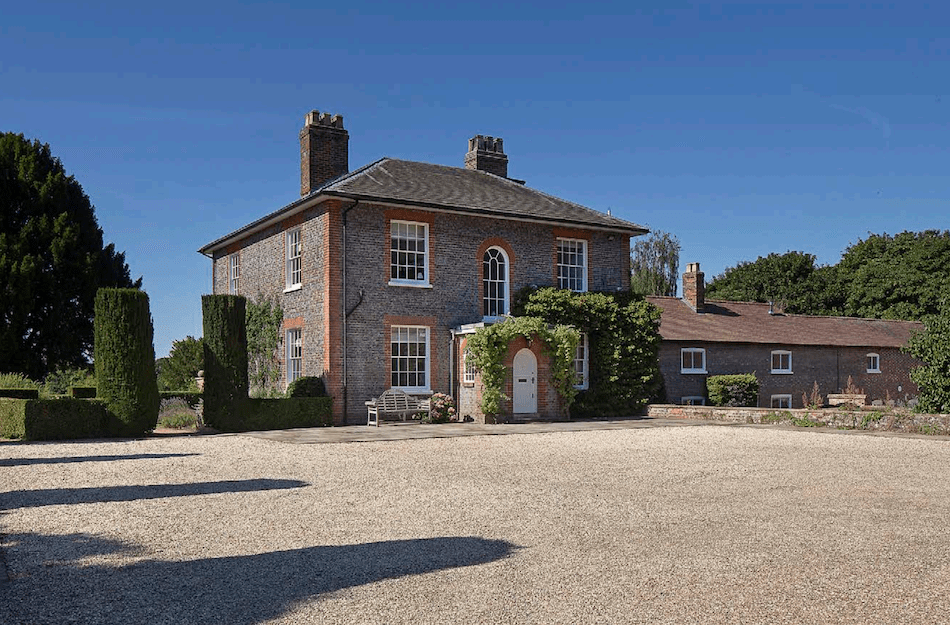Jerome K Jerome’s Three Men in a Boat – a tale of three hapless, hypochondriac London clerks who take a trip along the River Thames in the hope of curing their ailments – became an instant bestseller when it was published in 1889, and hasn’t been out of print since. Bruce Chatwin, Paul Theroux and Bill Bryson all owe it to Jerome.
The book’s success meant that in 1895, Walsall-born Jerome (then in his mid thirties) could make a move to a rambling Oxfordshire house, built in the 1820s on the site of an ancient monastery.
Although he clearly had a fondness for the Thames, the home he chose wasn’t quite on the waterfront. It was, however, in a glorious rural spot in the village of Ewelme, part of what is now the Chiltern Hills Area of Outstanding Natural Beauty.
In his 1926 memoir, My Life and Times, he wrote movingly of the home, known then as Gould’s Grove and today as Troy, and which he and Ettie shared with their daughter, Rowena, and his stepdaughter, Elsie. Despite its grand facade of local blue glazed bricks, with central Venetian arched window and domed porch, he described it modestly as ‘an old farmhouse on the hill above Wallingford’. It was somewhere, he wrote, that liked to spend solitary time, especially during the winter months, despite it being ‘a lonely house’. Much loved by owls, the house, he says, was ‘constantly whipped by the wind’, an unsettling combination that made him ‘feel sure I had heard the crying of a child’.
Making the Regency farmhouse home until 1908, Jerome, who had aspired to be an actor in his younger years, and wrote nine plays in his lifetime, including The Passing of the Third Floor Back, built two theatres at the property, where he staged productions. He and Ettie also threw fashionable Edwardian house parties here, and were visited by an astonishing cast of literary luminaries of their day. Many ended up working at Troy, too: a circular thatched flint-and-stone summerhouse served as writing retreat to HG Wells, Sir Arthur Conan Doyle, Israel Zangwill and Eden Phillpotts.
‘There was a corner of the garden that we called the Nook’, Jerome wrote in his memoir:
A thick yew hedge, the haunt of birds, surrounded it, and an old nut tree gave shelter from the sun. It made a pleasant working place. An interesting tablet might be placed above its green archway, commemorating the names of those who had written there… Zangwill wrote stories of the ghetto there; but wasted much of his time, playing with the birds, digging up worms with the end of his pen to feed the young thrushes and blackbirds.
Today, the now Grade II listed nine-bedroom house is protected from any bracing breezes, with its enchanting grounds recently landscaped and planted by award-winning garden designer Todd Longstaffe-Gowan, who is a Gardens Adviser to Historic Royal Palaces and has worked with the National Trust and Historic England.
It’s just one part of Troy’s metamorphosis over the generations from windswept farmhouse to boutique hotel-worthy rural retreat, just nine miles from well-heeled Henley-on-Thames. Since Jerome left the house to move to Buckinghamshire, the house has, of course, passed through a series of owners, and its footprint has evolved: in the mid-1920s, the farmhouse was joined to the next door cottages and barns, creating a west wing and courtyard, creating about 8,000 square feet of living space, and at least four main reception rooms.
Jerome clearly never forgot his time at Troy
Remarkably, Troy remained in the possession of the same family for two generations until 2018, who lovingly renovated and cared for it. Since then, it has been in the ownership of another family, who prefer to remain anonymous, but who have carried out an ambitious refurb to the entire property.
Beyond the sweeping gravel driveway, brick pillars and iron gates, the completely upgraded high-ceilinged three-storey home retains original features such as elegant panelling, parquet flooring and open fireplaces, but has been given all the requisite lustworthy hallmarks of a luxuriously contemporary country home. With the help of Earl’s Court-based Alex Cochrane Architects, there’s a new Plain English kitchen plus butler’s pantry and boot room, and a magazine spread-worthy self-contained one-bedroom apartment in the west wing.
Across the forecourt from the main house is a wisteria-clad single storey building, built from the same blue brick as the main house, with semicircular Venetian-style windows and arched doorway. It was here, in what was once part of the stable block, that Jerome created a theatre space, its stage still with the Edwardian fireplace no doubt used to set many a scene.
The summerhouse where Jerome and friends wrote is now partnered by a second, rectangular flint and thatched summerhouse, with French windows opening on to a paved terrace, with a new outdoor heated swimming pool nearby.
Despite the exacting facelift, Troy’s owners have now put it on the market for offers in excess of £6 million, which includes the 46-plus acres, a tennis court and a series of outbuildings, which take in stabling, a barn and a flower room.
Jerome clearly never forgot his time at Troy. After his death in 1927, he was buried in the graveyard of the local church, St Mary’s. One can’t help thinking he would approve of the home’s recent immaculate refurb. His novel They and I, published in 1909, tells the story of a writer who buys a country house, and has to lodge with his family in a nearby cottage while it is being renovated.‘“I want a house that has got over all its troubles’, he wrote. ‘I don’t want to spend the rest of my life bringing up a young and inexperienced house.’
Knight Frank, +44 (0)1491 844900, knightfrank.co.uk; Savills +44 (0)1491 843000, savills.co.uk






Comments